|
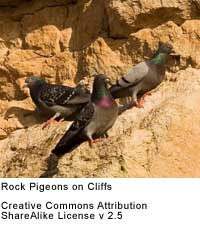
I. The Rock Pigeon: rat with wings?
The Rock Pigeon: The Rock Pigeon (Columba livia), is a member of the bird family Columbidae, doves and pigeons. The bird
is also known by the names of feral pigeon
or domestic pigeon. In common usage,
this bird is often simply referred to as the "pigeon." The species was commonly known as Rock Dove until the British Ornithologists' Union and the American Ornithologists'
Union changed the official English name of
the bird in their regions to Rock Pigeon.
The Domesticated Rock Pigeon: Rock Pigeons have been domesticated for several thousand years, giving rise to the domestic pigeon. Trained domestic pigeons are
able to return to the home loft if released at a location that they have never visited before and that may be up to 1000 km away. A special breed, called homing pigeons has been developed through selective breeding to carry messages and members of this variety of pigeon are still being used in pigeon racing. The species was first introduced to North America in 1606 at Port Royal, Acadia (now Nova Scotia).
The Feral Rock Pigeon: Many domestic Rock Pigeons have escaped or been released over the years, and have given rise to the feral pigeon. These show a variety of plumages, although some look very like the pure Rock Pigeons. The scarcity of the pure wild species is due to interbreeding with feral birds.

The Rock Pigeon is 30–35 cm long with a 62–68 cm wingspan. The white lower back of the pure Rock Pigeon is its best identifying feature, but the two black bars on its pale grey wings are also distinctive. The tail is margined with white. It is strong and quick on the wing, dashing out from sea caves, flying low over the water, its white rump showing well from above.
Features: The head and neck of the mature bird are a darker blue-grey than the back and wings; the lower back is white. The green and lilac or purple patch on the side of the neck is larger than that of the Stock Dove, and the tail is more distinctly banded. Young birds show little lustre and are duller. Eye colour of the pigeon is generally an orange colour but a few pigeons may have white-grey eyes. The eyelids are orange in colour and are encapsulated in a grey-white eye ring.
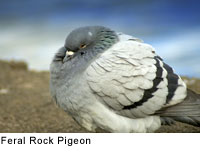 When circling overhead, the white under wing of the bird becomes conspicuous. In its flight, behaviour, and voice, which is more of a dovecot coo than the phrase of the Wood Pigeon. Although it is a relatively strong flier, it also glides frequently, holding its wings in a very pronounced V shape as it does. When circling overhead, the white under wing of the bird becomes conspicuous. In its flight, behaviour, and voice, which is more of a dovecot coo than the phrase of the Wood Pigeon. Although it is a relatively strong flier, it also glides frequently, holding its wings in a very pronounced V shape as it does.
Feral Pigeons: Feral Pigeons commonly show a very wide range of plumage variation.

Rock Pigeon: The wild Rock Pigeon has a restricted natural resident range in western and southern Europe, North Africa, and into southwest Asia. Its habitat is natural cliffs, usually on coasts. Its domesticated form, the feral pigeon, has been widely introduced elsewhere, and is common, especially in cities, over much of the world. In Britain, Ireland, and much of its former range, the Rock Pigeon probably only occurs pure in the most remote areas. A Rock Pigeon's life span is anywhere from 3–5 years in the wild to 15 years in captivity, though longer-lived specimens have been reported. Though fields are visited for grain and green food, it is nowhere so plentiful as to
be
a pest.
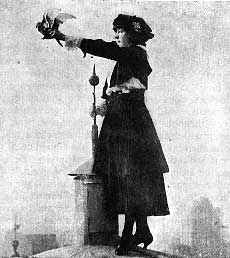 Domestic Rock Pigeon: Many people consider pigeons to be pests but they have made contributions of considerable importance to humanity, especially in times of war. In war the homing ability of pigeons has been put to use by making them messengers. So-called war pigeons have carried many vital messages and some have been decorated for their service. Medals such as the Croix de guerre, awarded to Cher Ami, and the Dickin Medal awarded to G.I. Joe have been given to pigeons for their service. Domestic Rock Pigeon: Many people consider pigeons to be pests but they have made contributions of considerable importance to humanity, especially in times of war. In war the homing ability of pigeons has been put to use by making them messengers. So-called war pigeons have carried many vital messages and some have been decorated for their service. Medals such as the Croix de guerre, awarded to Cher Ami, and the Dickin Medal awarded to G.I. Joe have been given to pigeons for their service.
Domestic pigeons are also commonly used in laboratory experiments in biology, medicine and cognitive science. They have been trained to distinguish between cubist and impressionist paintings, for instance. In another project, pigeons were shown to be more effective than humans in spotting shipwreck victims at sea. Current (2004) research in pigeons is widespread, encompassing shape and texture perception, exemplar and prototype memory, category-based and associative concepts, and many more unlisted here (see Pigeon intelligence and discrimination abilities of pigeons).
Feral Pigeon: Feral pigeons can be seen eating grass seeds and berries in urban parks and gardens in the spring, but there are plentiful sources throughout the year from scavenging (e.g. dropped fast-food cartons). Further food is also usually available from the disposing of stale bread in parks by restaurants and supermarkets, from tourists buying and distributing birdseed, etc.
Navigation Ability: Pigeons' extraordinary navigation abilities have been attributed to the theory that they are able to sense the Earth's magnetic field with tiny magnetic tissues in their head. This is all the more surprising as they are not a migratory species, which is a fact used by some ornithologists to dispute the "compass pigeon" theory.

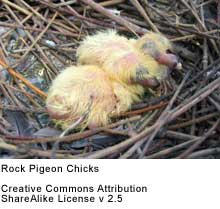 Rock Pigeon Nest and Nestling: The Rock Pigeon's nest is usually on a ledge in a cave; it is a slight structure of grass, heather, or seaweed. Like most pigeons Rock Pigeon Nest and Nestling: The Rock Pigeon's nest is usually on a ledge in a cave; it is a slight structure of grass, heather, or seaweed. Like most pigeons
it lays two white eggs. The eggs are incubated by both parents for about 18 days. The nestling has pale yellow
down and a flesh-coloured bill with a dark band. It is tended and fed on "milk" like other doves. The fledging period is 30 days.
Feral Pigeon Nest and Nestling: Pigeons breed when the food supply is good — for wild rock doves this might
be on a seasonal basis so they usually breed once a year. In the urban environment, because of their year-round food supply, feral pigeons will breed continuously, laying eggs up to six times a year.
As a result of the continuous food supply, pigeon courtship rituals can be observed in urban parks at any time of the year. Males on the ground initially puff up feathers at the nape of the neck to increase their apparent size and thereby impress or attract attention, then they single out a female in the vicinity and approach at a rapid walk, often bowing as they approach. Females invariably initially walk away or fly short distances, the males follow them at each stage. Persistence by the male will usually eventually cause the female to tolerate his proximity, at which point he will continue the bowing motion and very often turn full- or half-pirouettes in front of the female. Subsequent mating when observed is very brief with the male flapping his wings to maintain balance on the female. Sometimes the male and female beaks are
locked together.
Feral Pigeon Nests: Nests are rudimentary as for the wild doves and pigeons. Favourite nesting areas are in damaged property. Mass nesting is common
with dozens of birds sharing a building. Loose tiles and broken windows give pigeons access — they are remarkably good at spotting when new access points become available for example after strong 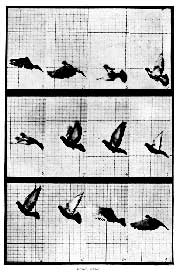 winds cause property damage. Nests and droppings will quickly make a mess of any nesting area. Pigeons are particularly fond of roof spaces containing water tanks, though they frequently seem to fall into the tanks and drown. Any winds cause property damage. Nests and droppings will quickly make a mess of any nesting area. Pigeons are particularly fond of roof spaces containing water tanks, though they frequently seem to fall into the tanks and drown. Any
water tank or cistern in a roof space needs to have a secure lid for this reason. The popularity of a nesting area seems little affected if pigeons
die or are killed there — corpses are seen among live birds, who seem unconcerned.
On undamaged property the gutters, chimney pots and external ledges will be used as nesting sites. Many building owners attempt to limit roosting by using bird control spikes and netting to cover ledges and resting places on the facades of buildings. These probably have little effect
on the size of pigeon populations, but can help to reduce the accumulation of droppings on and around an individual building.
The coo-ing of the feral pigeon is almost continuous when birds are on a nest, it is rarely heard at other times except courtship. Males are at least as likely to be on the nest as females, though a pair of birds will attend the nest.

Feral pigeons in cities: Many city squares are famous for their large pigeon populations, including...
Trafalgar Square — London
Dam Square — Amsterdam
Martin Place — Sydney
Piazza San Marco — Venice
Misir Carshisi — Istanbul
Rynek Glówny — Cracow
Richard J. Daley Center — Chicago
Piccadilly Gardens — Manchester
In Zurich, many places where pigeons could land are covered with spikes. In the mid 20th century, the pigeons in Trafalgar Square were considered a tourist attraction, with street vendors selling packets of seeds for visitors to feed the pigeons. However this practice is now actively discouraged and, as with many other cities, the feeding of pigeons is forbidden. Although pest exterminators using poison, a hawk or nets have been employed at ground level to control urban pigeon populations, the effect is limited and very short term.
Peregrine Falcons which are also originally cliff dwellers have also adapted to the big cities, living on the window ledges of skyscrapers and often feeding exclusively on Rock Pigeons.
Pigeon Domestication: Pigeons are also bred for meat and by fanciers to develop many exotic forms. Among those forms are the carrier pigeons, a variety of pigeon with wattles and a unique, almost vertical, stance. Young pigeon meat is often sold under the name squab.
--------------------------------------------------------------------------------------------------------------------------
II. Passenger Pigeon:
 Life and Extinction: The Passenger Pigeon (Ectopistes migratorius) was Life and Extinction: The Passenger Pigeon (Ectopistes migratorius) was
once probably the most common bird in the world. It is estimated that there
were as many as five billion passenger pigeons in the United States. They lived
in enormous flocks—the largest of them
a mile (1.6 km) wide and 300 miles
(500 km) long, taking several days to pass and probably containing two billion birds.
It was hunted into extinction by humans.
Way of Life: The Passenger Pigeon was a very social bird. It lived in colonies with up to a hundred nests in a single tree, and stretching over hundreds of square miles. During summer, Passenger Pigeons lived throughout the part of North America east of the Rocky Mountains. In the winter, they lived in the southern U.S.
Passenger Pigeon Hunting: It was hunted for food, hog feed, as live targets for trap shooting and even sometimes as agricultural fertilizer, and shipped by the boxcar-load to the Eastern cities. In New York City in 1805, a brace (pair) of pigeons sold for two cents. Slaves and servants in 18th and 19th century America often saw no other meat. Commercial hunters harvested them in huge amounts for food, and most restaurants in the Eastern United States served pigeon to customers.
Dropping Populations: In the mid-1800s, it was noticeable that their numbers were dropping. The passenger pigeon only laid one egg at a time, so once numbers started to decline it would have taken time for them to start rising again. Almost all of the remaining quarter-million Passenger Pigeons were killed in a single day in 1896 by sport hunters, who knew they were shooting the last wild flock. The last wild Passenger Pigeon was shot by a 14-year-old boy in Ohio in March of 1900.
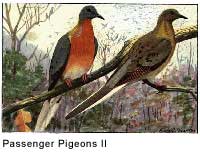 Deforestation: Other significant reasons for its extinction were deforestation (the birds relied on acorn and beech mast for breeding. Deforestation: Other significant reasons for its extinction were deforestation (the birds relied on acorn and beech mast for breeding.
Social Factors: The birds seemed to have initiated courtship and reproduction when they were gathered in large numbers; it was noted that small groups of Passenger Pigeons were notoriously difficult to get to breed successfully.
The Last Passenger Pigeon: The last Passenger Pigeon, named Martha, died in the Cincinnati Zoo on September 1, 1914. She was frozen into a block of ice and sent to the Smithsonian Institution and was skinned and mounted. She may be seen there to this day.

Popular Culture: The musician John Herald wrote a song about Martha: "Martha (Last of the Passenger Pigeons)". Also, the indie rock band
Paint by Numbers wrote a 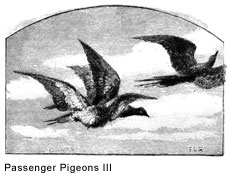 song titled "Sweet song titled "Sweet
Sweet Martha" to commemorate her death.
The April 27, 1948 episode of the Fibber McGee and Molly radio program is titled "The Passenger Pigeon Trap", in which McGee claims to have seen a Passenger Pigeon (he insists that the bird is "stinct")
and plans to trap it in order to sell it to
the highest bidder. It turns out to be nothing more than a Rock Pigeon (Columba livia) sitting on top of a bus, which in McGee's mind makes the pigeon a passenger.
Stephen King makes a number of references to the Passenger Pigeon in the 2005 Novel "Cell". He uses the Passenger pigeon as an allegory to the new human hive mind that develops after the pulse hits the United States.
Across North America, place-names refer to the former abundance of the Passenger Pigeon.
All text is available under the terms
of the GNU Free Documentation License
|